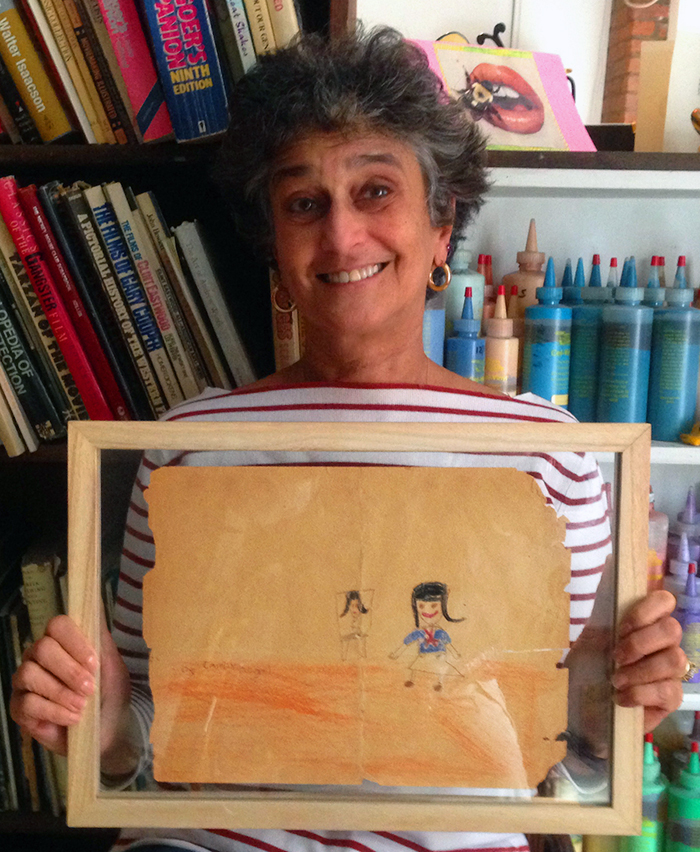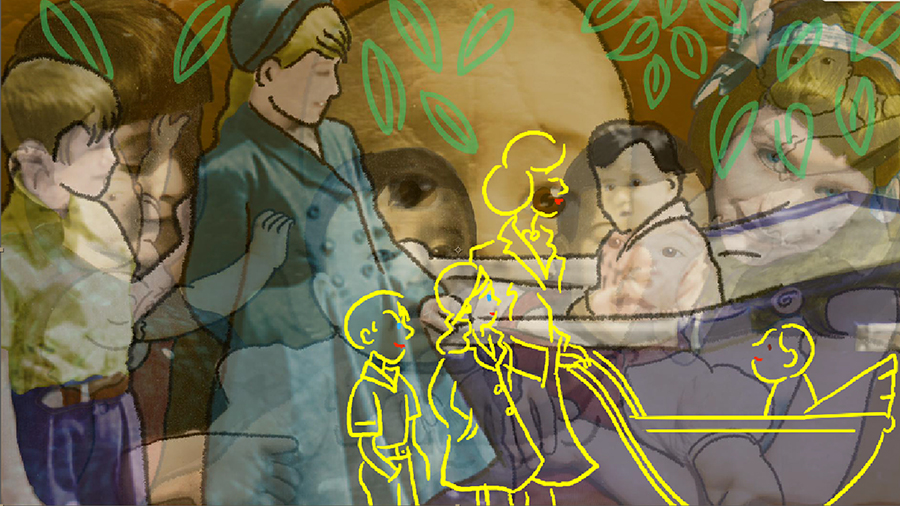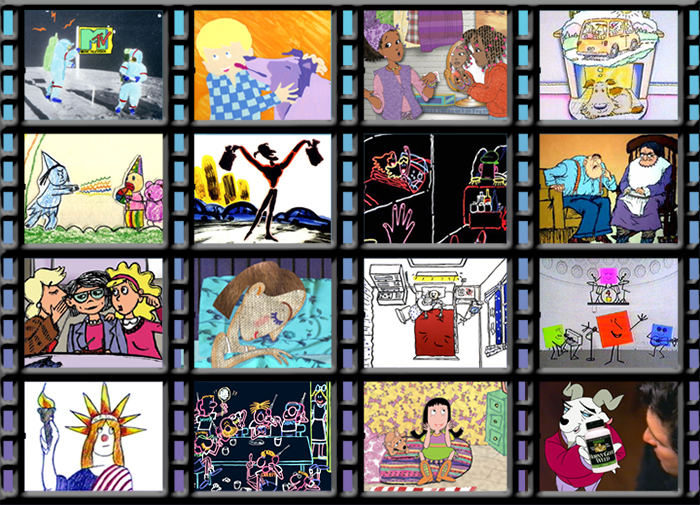WIA SPOTLIGHT STORIES
SPOTLIGHT STORIES: CANDY KUGEL
Interview conducted by Tracey Miller-Zarneke
Candy Kugel has had an incredible career in our industry, approaching a half-century of animation in commercial, television and feature production including pieces that ring nostalgic for many of us, with Sesame Street and MTV being two iconic outlets that have showcased her work. Her East Coast presence has inspired great visual story-telling over multiple generations, and now she has finally found the time to create and tell her own story in her own featurette, I, Candy, which has been showing at festivals and special events around the world.
WIA is thrilled to share some of Candy’s personal experience and perspective with our membership.
Think back to the earliest moment in your life when you realized you loved creating art and please share it with us.
I can’t remember a time when I didn’t love making things with my hands! From a very young age I would lie on my belly and draw on scrap paper—paper bags, notebook paper, note pads or envelopes– while watching TV. Or I would knit.
Did your parents/family encourage you in your pursuit of art as a career? If so, how? If not, how did you move forward in your pursuit?
My mother’s family did more so than my father’s—and most specifically my mother’s brother, Uncle Richard Roth. He was an accomplished water colorist and painter and he gave me art supplies on every birthday. He had been a set painter in Hollywood when he was black-listed by organizing artists in the late 1940s and 1950. When he moved to New York to escape the list, he became a book designer at McGraw Hill, but he continued painting on his own.
My father had no use for art for art’s sake — he’d determine the quality of painting on whether it would look good in his living room. His view was that an artist needed to earn money or they weren’t a real artist. He didn’t understand art past the 19th century Academic paintings. I think that might be why I needed to work commercially first.
Who were/are your mentors, inside or outside of animation? How have they affected you?
I suppose aside from my very supportive uncle (see above) my advisor, Thomas Sgouros at RISD, was a big influence. He was a gifted painter and illustrator. In his illustration classes, he’d say that a blank piece of paper had its own integrity, and whatever you add to it should contain its own integrity. That has always been my aim! And he encouraged my interest in animation which was not part of RISD’s curriculum back then. After my first summer job at Perpetual Motion Pictures, he sponsored my independent study in animation. He secured space and equipment for me in the film department in order to do some animation exercises and then encouraged me to continue that pursuit in the European Honors Program in Rome.
My first mentor in animation was the designer Hal Silvermintz of Perpetual Motion Pictures. He was intensely curious and was always searching for unusual influences for animation design. He didn’t stick with only one style. He taught me to keep on looking! My longtime creative partner, Vincent Cafarelli, was, at first, another important mentor. He not only taught me the basics of movement, but encouraged me to expand my vision in animation. Later, as business partners, he agreed to collaborate on our more than a dozen independent films and I can still hear him in my mind when I animate!
Have you ever served as a mentor? If so, how has being on that side of the equation helped you?
Since we formed Buzzco Associates in the mid-1980s, we have had interns regularly. Usually they were students between their 3rd and final year of college. In exchange for helping with errands and other tasks, we would provide space, time and advice on their upcoming thesis films. I have enjoyed watching their progress, not only for the summers they were here, but also in watching their futures evolve both in and outside animation. And often, in providing help for the interns, I have learned a lot from them in their vision!
Why is an organization like Women in Animation important?
In the past, women were pigeonholed into gender based jobs even though they were as qualified and capable of performing as their male counterparts. WIA gives that exposure to allow women to work to their full potential, important as ever in the #metoo era. Although personally I have been extremely lucky working in New York, where it was easier not to be pigeon-holed in a specialty or craft, I have seen it hasn’t been that easy for women in other places. And women who are already established in a career can often relate to issues specific to women just entering the workplace.
How has the status of women in our industry shifted over the course of your career? How has this affected your career path, if at all?
When I entered the industry in New York, most women were in the background, design and ink and paint departments. Tissa David was the only female animator I saw. But I wanted to animate—to act! I was stage struck and would have liked to be an actor, but I couldn’t let myself get into the character physically. I loved the idea that my drawings could do what I wanted to do in real life! Women weren’t encouraged to go through the long training process to become a journeyman animator—it usually took about six years for a person to advance from inbetweener to assistant to animator, and it was assumed that women would quit to get married and have children. I started working in the early 70s, during the women’s liberation movement, and I couldn’t relate to that idea– I wanted to learn and experience everything. By 1976, attending the first Ottawa International Animation Festival, I found many independent women animators—Janet Perlman, Caroline Leaf, Kathy Rose, and many more. They made me even more determined to be part of that group.
What, if any, adversities have you faced in your career or life in general, and how did they shape the leader you are today?
There were plenty—society has a way of trying to keep the status quo; family responsibilities and life always try to interfere with one’s ideal vision of career and life choices. But I didn’t want to become a victim—or complain about things I had no control over. It was easier for me to keep on putting one step in front of the other, and it’s pretty amazing to look back on the footprints!
Share with us a moment of exhilaration in your career.
Oh, hell! That’s easy! It was the last couple of months! It started with the Museum of Modern Art’s “Modern Monday with Candy Kugel” where “I, Candy” had the first public screening. That program also included John Canemaker’s interview with me, and screenings of some of my early work, both commercial and three of our independent shorts. They were shown on the big screen — actual film prints with MoMA’s wonderful sound system (I hadn’t seen these films projected for decades!!) to a sold out audience! Then in May, I received ASIFA East’s award for “I, Candy” (as well as a special recognition award from WIA) and experienced the audience reaction!! And … then screenings in Bagnoregio, Italy and Annecy, France. Ahhhh….
What compelled you to produce I, Candy? What do you hope your audiences gain from watching your film?
I was given a kill fee for a Christmas TV special that I had been attached to which needed another director for financial/tax reasons. I was completely devastated, but I realized that what I wanted to use that money for would be to make a film of my own. I have found that at turning points in my life I have had the impulse to examine my situation through making animated films—sometimes more disguised self-portraits than this one became!
My mother had kept a picture I drew in the first grade which showed me, in my favorite dress, next to an easel with a less defined self-portrait (like a real painting!) I used this drawing to examine my life/career. And yes, I hope my audience can get inspiration from this film—there are set-backs, life is not an exact bee-line to a goal— but with determination and elasticity, you can have a very fulfilling life and career.
What advice do you have for young people looking at animation or other artistic industries as their career field?
Enjoy the process! It’s not always easy to have a career, but keep on keeping on. See challenges as puzzles that need to be solved. Try to have fun while doing it!
What do you believe will encourage women to enter the creative field and seek to become leaders in such industry?
I’m not sure that if someone (male or female) doesn’t have the urgent need inside to be creative, that there’s anything that can encourage them to do it. If one’s interest is to become rich and famous, there are probably lots of other ways to achieve that without the heartbreak of competing in the creative fields. And leader? I’m not sure being the “leader” is as satisfying as being able to make the work. I’m not sure if I’m considered a leader—my greatest joy is working with others, collaborating, eliciting ideas and creating something with others.
How do you keep your artistic spirit refreshed, even when under the pressure of production deadlines or life challenges?
My artistic spirit raises its own head in my independent work, which is often born out of life challenges—but you’re right—in commissioned work, the idea that it’s a puzzle that needs to be solved is what pushes me to be creative within those parameters. And now, since I’ve found I can produce work on my own and that I really enjoy making films, as much at any earlier time— at this point in my career— I look forward to my future projects!
WIA wishes Candy great fun and success with I, Candy and the many stories she will still tell after that.



